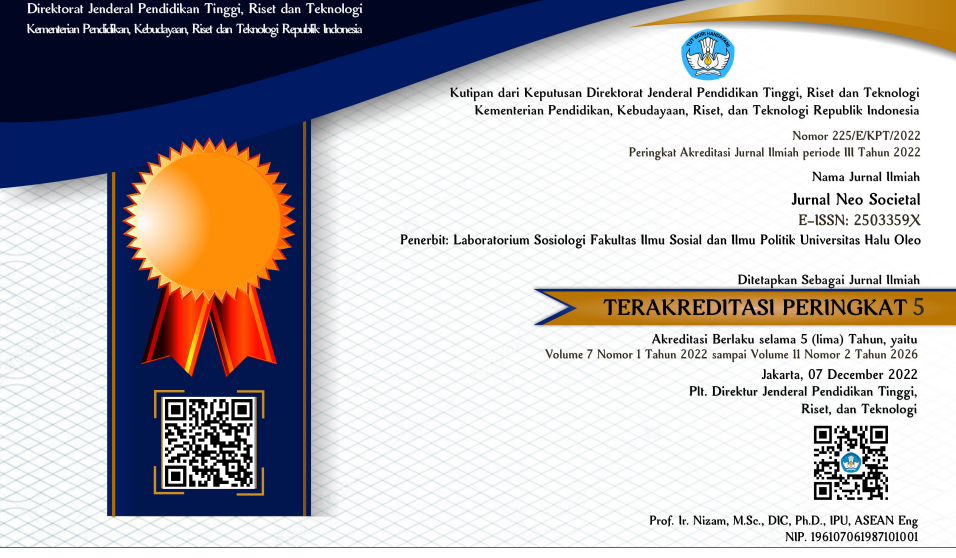PROSES DAN MAKNA RITUAL BUDAYA KASEBU
Keywords:
Budaya Kasebu, Proses dan Makna, Ritual BudayaAbstract
Kasebu traditional rituals are traditions that continue to be sustainable in the midst of the times while still running in accordance with the process that has been taught by the ancestors. This paper aims to describe and analyze the process and symbols of the implementation of Kasebu traditional rituals. This study used a qualitative descriptive approach. Data collection techniques include observation, interviews and documentation. The results of this study show that the process and symbols of implementing the Kasebu tradition are: (1) the recitation of prayers (podula) with the symbol of nine gutters containing food prepared by traditional leaders (kamokulano liwu). (2) Saare is a movement performed by a man dressed in traditional female clothes surrounded by a group of children with drum dance movements (po'toge). (3) Potumbu ritual, which is a morning ritual with freestyle physical competition in a field that has been determined following existing rules. (4) Desese oe mata is a ritual carried out by cleaning the spring water used as a water source requirement for the Wasilomata community. (5) Fomani, namely village silat performed by individuals and groups accompanied by large drums (ganda kapaso). (6) Double Kabueno as a closing ritual of Kasebu, which is the swing of drums from midnight to morning with the accompaniment of a certain Linda dance. In conclusion, the ritual process of Kasebu culture consists of the recitation of prayers (Podula), saare, Potumbu rituals, Fomani, and Kabueno Ganda.
References
Alwi, A. (2020). Solidaritas Masyarakat Multikultural dalam Menghadapi Covid-19. Prosiding Seminar Nasional Problematika Sosial Pandemi COVID-19 “Membangun Optimisme Di Tengah Pandemi Covid-19, 33–36.
Alwi, A., Kasnawi, T., Syukur, M., & Upe, A. (2022). Social Construction of Integration in Multicultural Society in West Muna Regency , Southeast Sulawesi Province. 6(6), 516–525.
Creswell, J. (2020). Second Edition Qualitative Inquiry& Research Design Choosing Among Five Approaches.
Geertz, C. (1973). Thick Description: Toward an Interpretive Theory of Culture. In The Interpretation of Cultures: Selected Essays (1973). In Basic Books, Inc. (pp. 310–323).
Kuper, A. (2014). Anthropology and Anthropologists: The Modern British School.
Maeu, A., Asmawati, E., & Hermina, S. (2020). Tradisi Kasebu Masyarakat Wasilomata Di Desa Wasilomata Ii Kecamatan Mawasangka Kabupaten Buton Tengah: 1930-2018. Journal Idea of History, 3(2), 73–79. https://doi.org/10.33772/history.v3i2.1124
Pals, D. L. (1966). Seven Theories of Religion.
Roibin, R. (2010). AGAMA DAN MITOS: Dari Imajinasi Kreatif Menuju Realitas yang Dinamis. El-HARAKAH (TERAKREDITASI). https://doi.org/10.18860/el.v0i0.445
Saafi, L. M. N., & Hendri. (2020). Jurnal Pendidikan Sejarah , Vol. VI, No. 1, Mei 2020. Jurnal Pendidikan Sejarah, VI(1), 63–76.
Santalia, I. (2022). Mosehei Wonuai (Studi Tentang Rituali Tolak Bala di Kolaka dalam Perspektif islam). Jurnal Mercusuar, 3(1), 17–49.
Upe, A., & Wahid, A. (2019). Paradigma Teori Kritis (Suatu Pengantar Untuk Memahami Sosiologi Kritik). CV. Literacy Institute.
Downloads
Published
How to Cite
Issue
Section
License
Copyright (c) 2023 ruslin ruslin

This work is licensed under a Creative Commons Attribution 4.0 International License.













